lock Lancia Delta 2011 Owner handbook (in English)
[x] Cancel search | Manufacturer: LANCIA, Model Year: 2011, Model line: Delta, Model: Lancia Delta 2011Pages: 290, PDF Size: 8.36 MB
Page 45 of 290
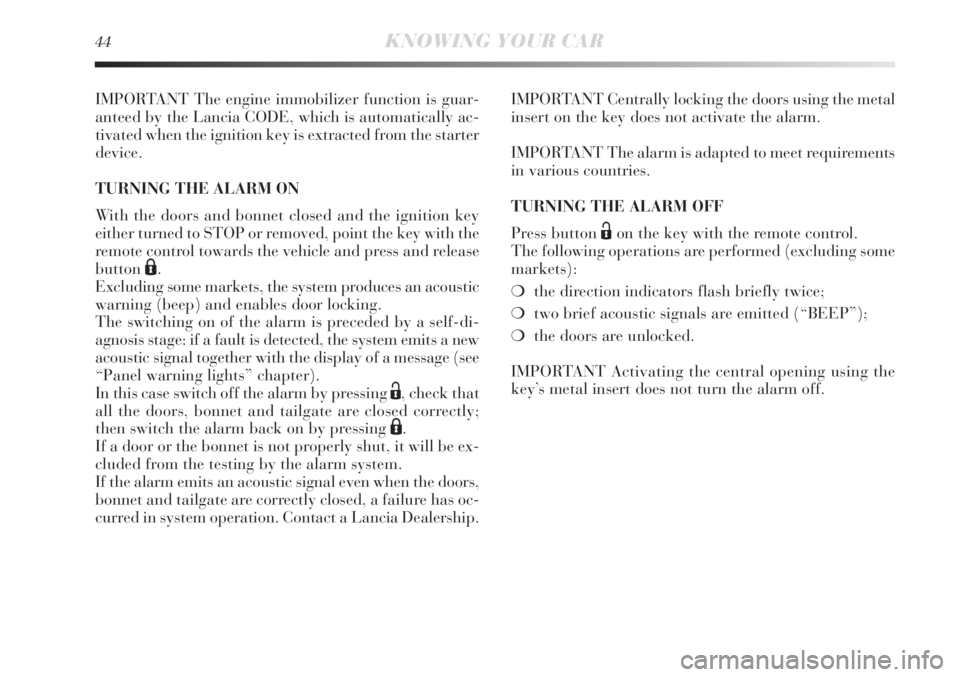
44KNOWING YOUR CAR
IMPORTANT The engine immobilizer function is guar-
anteed by the Lancia CODE, which is automatically ac-
tivated when the ignition key is extracted from the starter
device.
TURNING THE ALARM ON
With the doors and bonnet closed and the ignition key
either turned to STOP or removed, point the key with the
remote control towards the vehicle and press and release
button
Á.
Excluding some markets, the system produces an acoustic
warning (beep) and enables door locking.
The switching on of the alarm is preceded by a self-di-
agnosis stage: if a fault is detected, the system emits a new
acoustic signal together with the display of a message (see
“Panel warning lights” chapter).
In this case switch off the alarm by pressing
Ë, check that
all the doors, bonnet and tailgate are closed correctly;
then switch the alarm back on by pressing
Á.
If a door or the bonnet is not properly shut, it will be ex-
cluded from the testing by the alarm system.
If the alarm emits an acoustic signal even when the doors,
bonnet and tailgate are correctly closed, a failure has oc-
curred in system operation. Contact a Lancia Dealership.IMPORTANT Centrally locking the doors using the metal
insert on the key does not activate the alarm.
IMPORTANT The alarm is adapted to meet requirements
in various countries.
TURNING THE ALARM OFF
Press button
Ëon the key with the remote control.
The following operations are performed (excluding some
markets):
❍the direction indicators flash briefly twice;
❍two brief acoustic signals are emitted (“BEEP”);
❍the doors are unlocked.
IMPORTANT Activating the central opening using the
key’s metal insert does not turn the alarm off.
Page 46 of 290
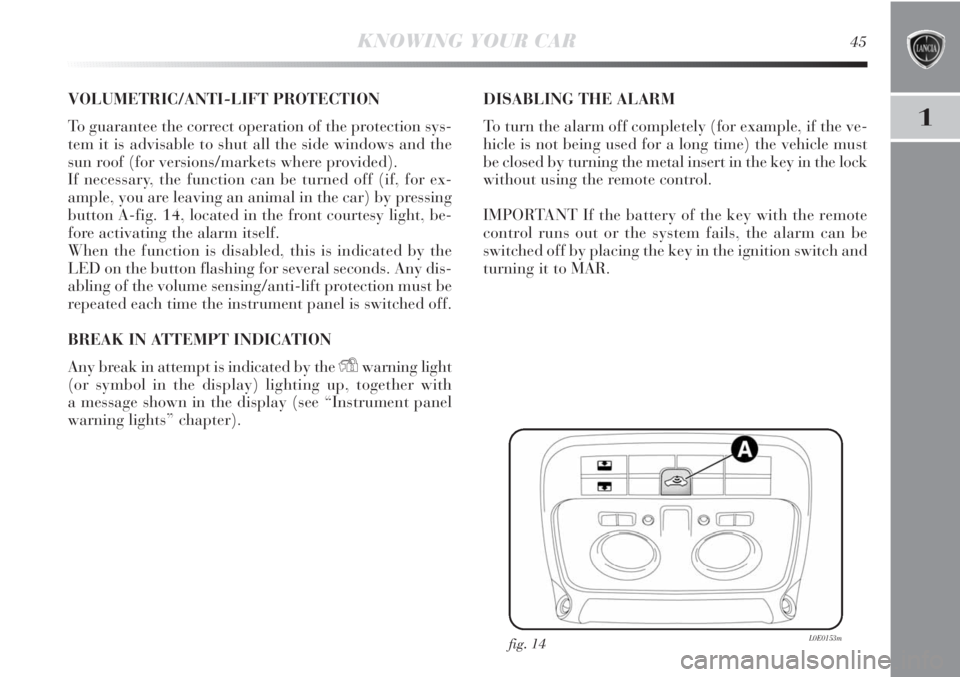
1
KNOWING YOUR CAR45
VOLUMETRIC/ANTI-LIFT PROTECTION
To guarantee the correct operation of the protection sys-
tem it is advisable to shut all the side windows and the
sun roof (for versions/markets where provided).
If necessary, the function can be turned off (if, for ex-
ample, you are leaving an animal in the car) by pressing
button A-fig. 14, located in the front courtesy light, be-
fore activating the alarm itself.
When the function is disabled, this is indicated by the
LED on the button flashing for several seconds. Any dis-
abling of the volume sensing/anti-lift protection must be
repeated each time the instrument panel is switched off.
BREAK IN ATTEMPT INDICATION
Any break in attempt is indicated by the
Ywarning light
(or symbol in the display) lighting up, together with
a message shown in the display (see “Instrument panel
warning lights” chapter).DISABLING THE ALARM
To turn the alarm off completely (for example, if the ve-
hicle is not being used for a long time) the vehicle must
be closed by turning the metal insert in the key in the lock
without using the remote control.
IMPORTANT If the battery of the key with the remote
control runs out or the system fails, the alarm can be
switched off by placing the key in the ignition switch and
turning it to MAR.
fig. 14L0E0153m
Page 47 of 290
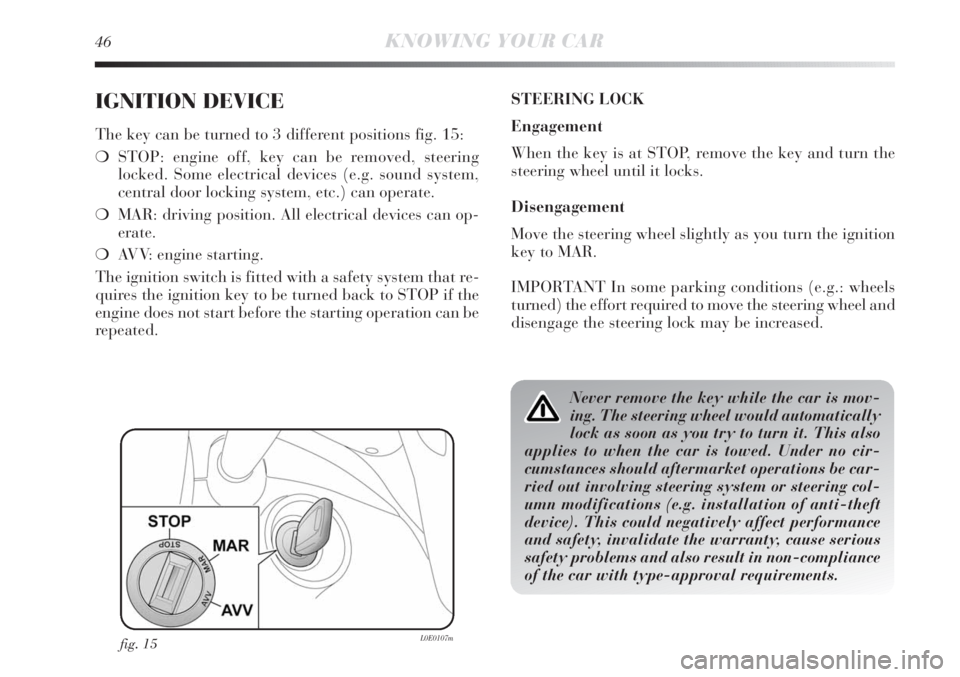
46KNOWING YOUR CAR
IGNITION DEVICE
The key can be turned to 3 different positions fig. 15:
❍STOP: engine off, key can be removed, steering
locked. Some electrical devices (e.g. sound system,
central door locking system, etc.) can operate.
❍MAR: driving position. All electrical devices can op-
erate.
❍AVV: engine starting.
The ignition switch is fitted with a safety system that re-
quires the ignition key to be turned back to STOP if the
engine does not start before the starting operation can be
repeated.STEERING LOCK
Engagement
When the key is at STOP, remove the key and turn the
steering wheel until it locks.
Disengagement
Move the steering wheel slightly as you turn the ignition
key to MAR.
IMPORTANT In some parking conditions (e.g.: wheels
turned) the effort required to move the steering wheel and
disengage the steering lock may be increased.
fig. 15L0E0107m
Never remove the key while the car is mov-
ing. The steering wheel would automatically
lock as soon as you try to turn it. This also
applies to when the car is towed. Under no cir-
cumstances should aftermarket operations be car-
ried out involving steering system or steering col-
umn modifications (e.g. installation of anti-theft
device). This could negatively affect performance
and safety, invalidate the warranty, cause serious
safety problems and also result in non-compliance
of the car with type-approval requirements.
Page 48 of 290
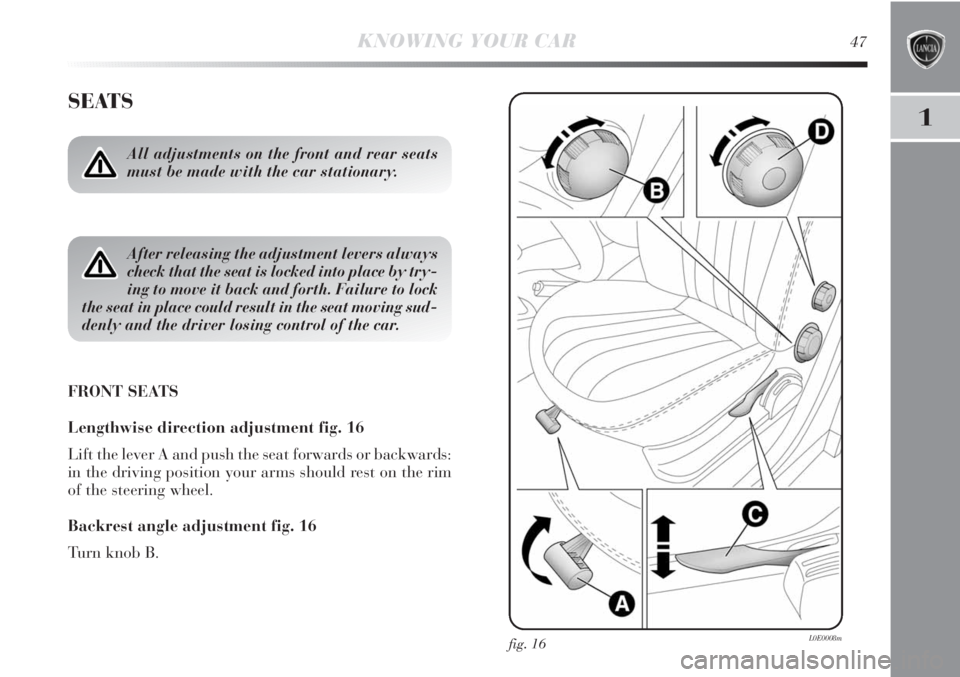
1
KNOWING YOUR CAR47
SEATS
FRONT SEATS
Lengthwise direction adjustment fig. 16
Lift the lever A and push the seat forwards or backwards:
in the driving position your arms should rest on the rim
of the steering wheel.
Backrest angle adjustment fig. 16
Turn knob B.
All adjustments on the front and rear seats
must be made with the car stationary.
After releasing the adjustment levers always
check that the seat is locked into place by try-
ing to move it back and forth. Failure to lock
the seat in place could result in the seat moving sud-
denly and the driver losing control of the car.
fig. 16L0E0008m
Page 51 of 290
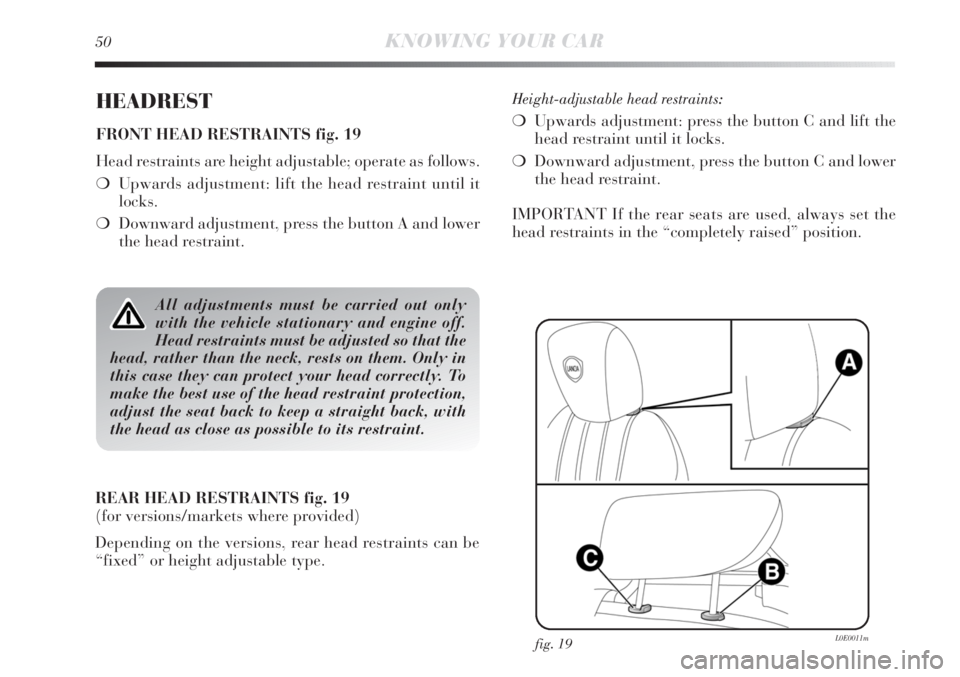
50KNOWING YOUR CAR
HEADREST
FRONT HEAD RESTRAINTS fig. 19
Head restraints are height adjustable; operate as follows.
❍Upwards adjustment: lift the head restraint until it
locks.
❍Downward adjustment, press the button A and lower
the head restraint.
fig. 19L0E0011m
Height-adjustable head restraints:
❍Upwards adjustment: press the button C and lift the
head restraint until it locks.
❍Downward adjustment, press the button C and lower
the head restraint.
IMPORTANT If the rear seats are used, always set the
head restraints in the “completely raised” position.
All adjustments must be carried out only
with the vehicle stationary and engine off.
Head restraints must be adjusted so that the
head, rather than the neck, rests on them. Only in
this case they can protect your head correctly. To
make the best use of the head restraint protection,
adjust the seat back to keep a straight back, with
the head as close as possible to its restraint.
REAR HEAD RESTRAINTS fig. 19
(for versions/markets where provided)
Depending on the versions, rear head restraints can be
“fixed” or height adjustable type.
Page 52 of 290
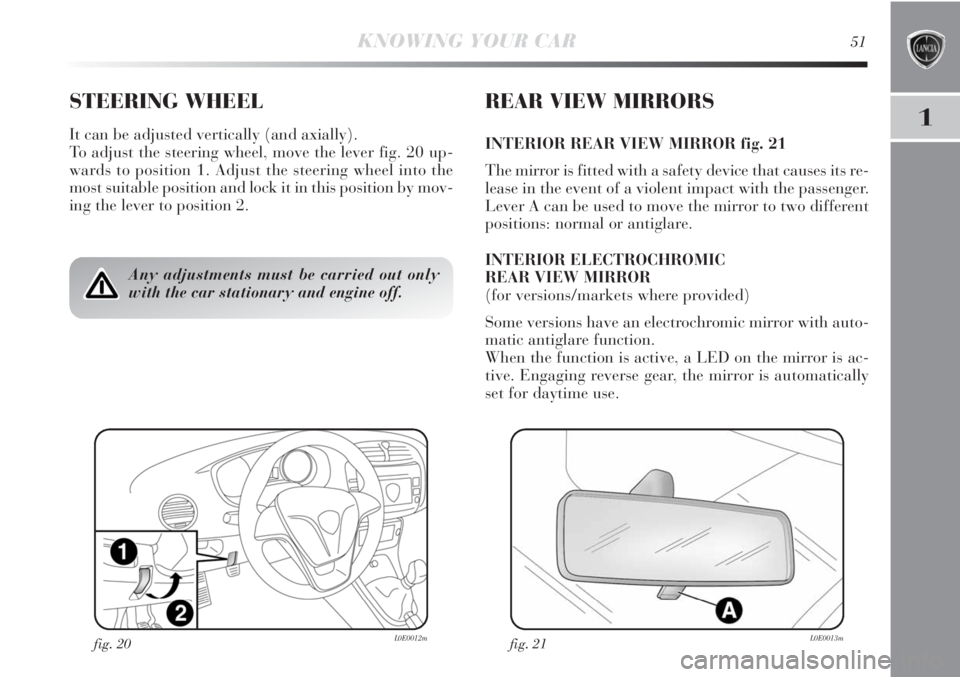
1
KNOWING YOUR CAR51
STEERING WHEEL
It can be adjusted vertically (and axially).
To adjust the steering wheel, move the lever fig. 20 up-
wards to position 1. Adjust the steering wheel into the
most suitable position and lock it in this position by mov-
ing the lever to position 2.
REAR VIEW MIRRORS
INTERIOR REAR VIEW MIRROR fig. 21
The mirror is fitted with a safety device that causes its re-
lease in the event of a violent impact with the passenger.
Lever A can be used to move the mirror to two different
positions: normal or antiglare.
INTERIOR ELECTROCHROMIC
REAR VIEW MIRROR
(for versions/markets where provided)
Some versions have an electrochromic mirror with auto-
matic antiglare function.
When the function is active, a LED on the mirror is ac-
tive. Engaging reverse gear, the mirror is automatically
set for daytime use.
Any adjustments must be carried out only
with the car stationary and engine off.
fig. 21L0E0013mfig. 20L0E0012m
Page 72 of 290
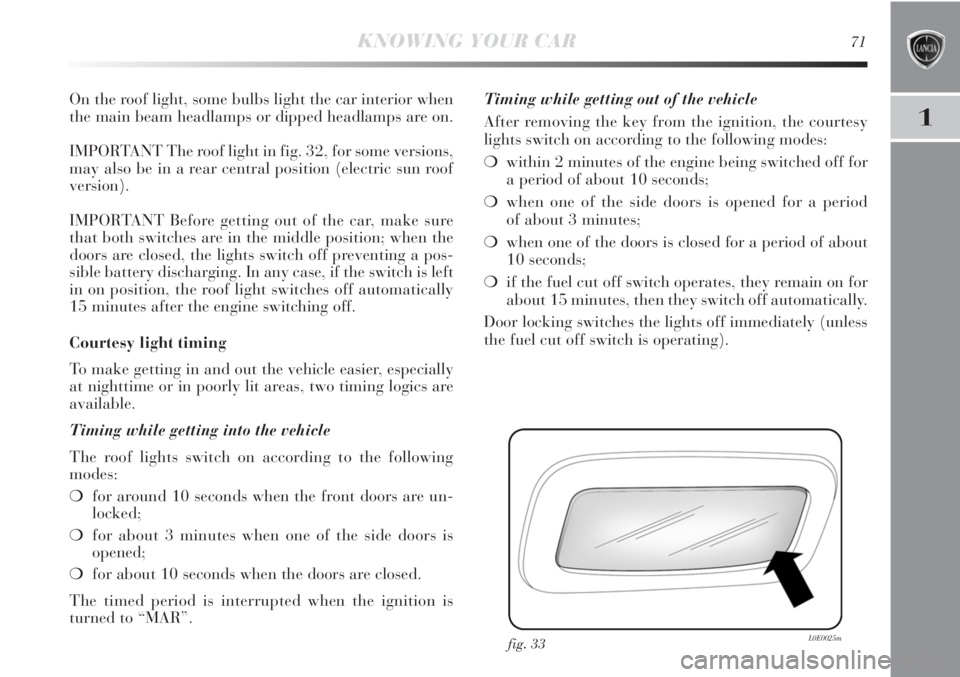
1
KNOWING YOUR CAR71
On the roof light, some bulbs light the car interior when
the main beam headlamps or dipped headlamps are on.
IMPORTANT The roof light in fig. 32, for some versions,
may also be in a rear central position (electric sun roof
version).
IMPORTANT Before getting out of the car, make sure
that both switches are in the middle position; when the
doors are closed, the lights switch off preventing a pos-
sible battery discharging. In any case, if the switch is left
in on position, the roof light switches off automatically
15 minutes after the engine switching off.
Courtesy light timing
To make getting in and out the vehicle easier, especially
at nighttime or in poorly lit areas, two timing logics are
available.
Timing while getting into the vehicle
The roof lights switch on according to the following
modes:
❍for around 10 seconds when the front doors are un-
locked;
❍for about 3 minutes when one of the side doors is
opened;
❍for about 10 seconds when the doors are closed.
The timed period is interrupted when the ignition is
turned to “MAR”.Timing while getting out of the vehicle
After removing the key from the ignition, the courtesy
lights switch on according to the following modes:
❍within 2 minutes of the engine being switched off for
a period of about 10 seconds;
❍when one of the side doors is opened for a period
of about 3 minutes;
❍when one of the doors is closed for a period of about
10 seconds;
❍if the fuel cut off switch operates, they remain on for
about 15 minutes, then they switch off automatically.
Door locking switches the lights off immediately (unless
the fuel cut off switch is operating).
fig. 33L0E0025m
Page 76 of 290

1
KNOWING YOUR CAR75
FUEL CUT-OFF SYSTEM
This intervenes in the case of an impact causing:
❍cut off of fuel supply with resultant engine shut down;
❍automatic door lock release;
❍activation of all lights inside the car.
When the system has been triggered, the message “Fuel
cut off, see handbook” is displayed.
Carefully check the car for fuel leaks, for instance in the
engine compartment, under the car or near the tank area.
Following a collision, turn the ignition key to STOP
to avoid draining the battery.To restore correct car operation, follow this procedure:
❍turn the ignition key to MAR;
❍activate the right hand indicator;
❍deactivate the right hand indicator;
❍activate the left hand indicator;
❍deactivate the left hand indicator;
❍activate the right hand indicator;
❍deactivate the right hand indicator;
❍activate the left hand indicator;
❍deactivate the left hand indicator;
❍turn the key to STOP.
If, after a crash, you smell fuel or notice
leaks from the fuel system, do not reactivate
the system to avoid the risk of fire.
Page 84 of 290

1
KNOWING YOUR CAR83
fig. 50L0E0109m
INITIALISATION PROCEDURE
After the battery has been disconnected or a fuse has
blown, the operation of the sun roof must be initialised
again.
Proceed as follows:
❍press button A-fig. 49 until the sun roof is completely
closed. Release the button;
❍press and hold down button A for at least 10 seconds
and/or until the glass panel moves forwards by one
click. Release the button at this point;
❍press button A within 5 seconds of this operation and
keep it pressed: the glass panel will complete a full
opening and closing cycle. Release the button only at
the end of this cycle.EMERGENCY OPERATION
If the switch does not work, the sunroof can be operated
manually as follows:
❍remove protective cap A-fig. 50 on the rear part of the
internal cover;
❍take the Allen key provided from the container with
the on-board documentation or from the luggage
compartment (versions with Fix&Go automatic);
❍fit the key into seat B and turn it:
– clockwise to open the roof;
– anticlockwise to close the roof.
Page 85 of 290

84KNOWING YOUR CAR
DOORS
LOCK/RELEASE FROM OUTSIDE fig. 51
Door release
To release all doors: turn the key to position 1. Pull up
the associated handle to open the door. Press button Ë
on the remote control to unlock the doors.
Before opening a door, ensure that you can
do it in conditions of safety. Open the doors
only when the car is stationary.
fig. 51L0E0042m
Door lock
To lock all doors: turn the key to position 2 with doors
fully closed.
Press button Áon the remote control to lock the doors.
If one of the doors is not shut properly, simultaneous lock-
ing is disabled.
IMPORTANT If one of the doors is not properly closed or
if there is a fault in the system, the central locking will
not engage. If the operation is repeated 10/11 times in
quick succession, the device is excluded for approxi-
mately 30 seconds.